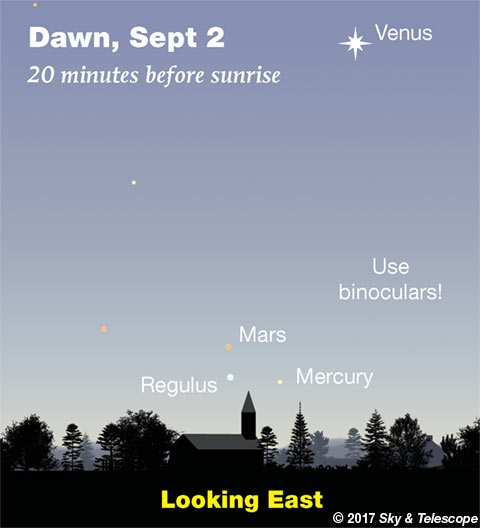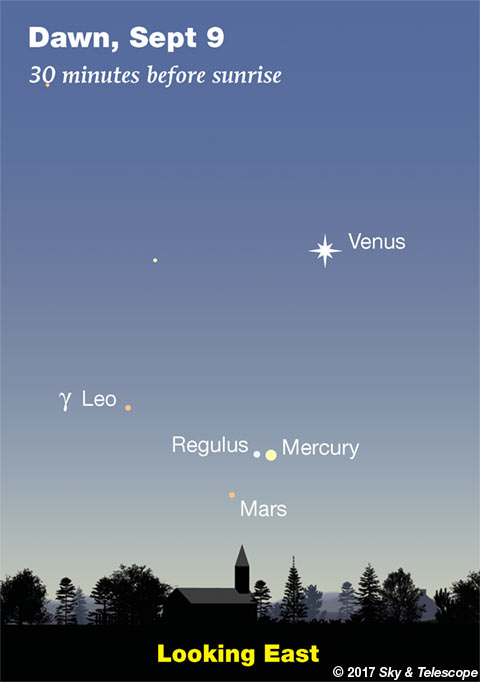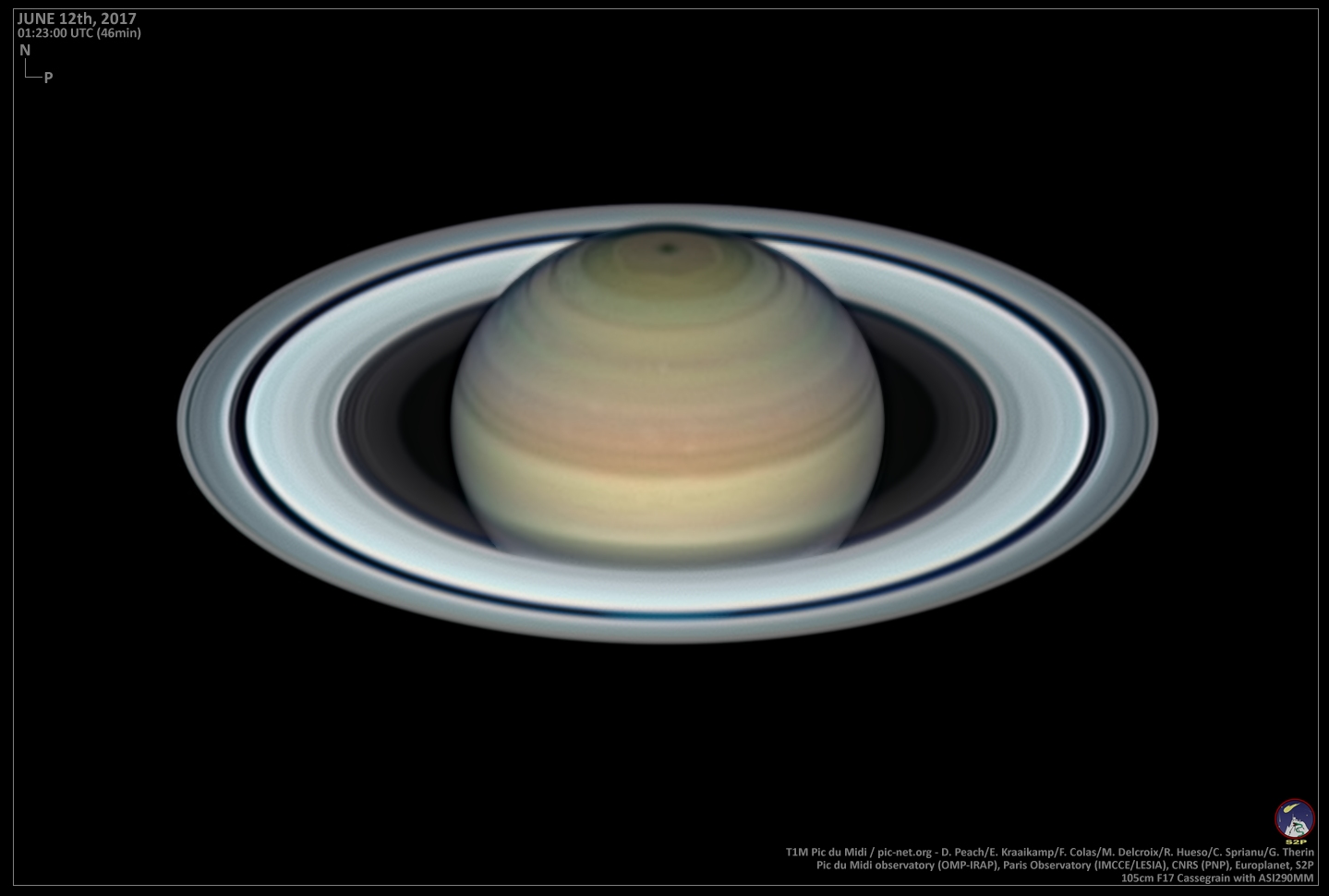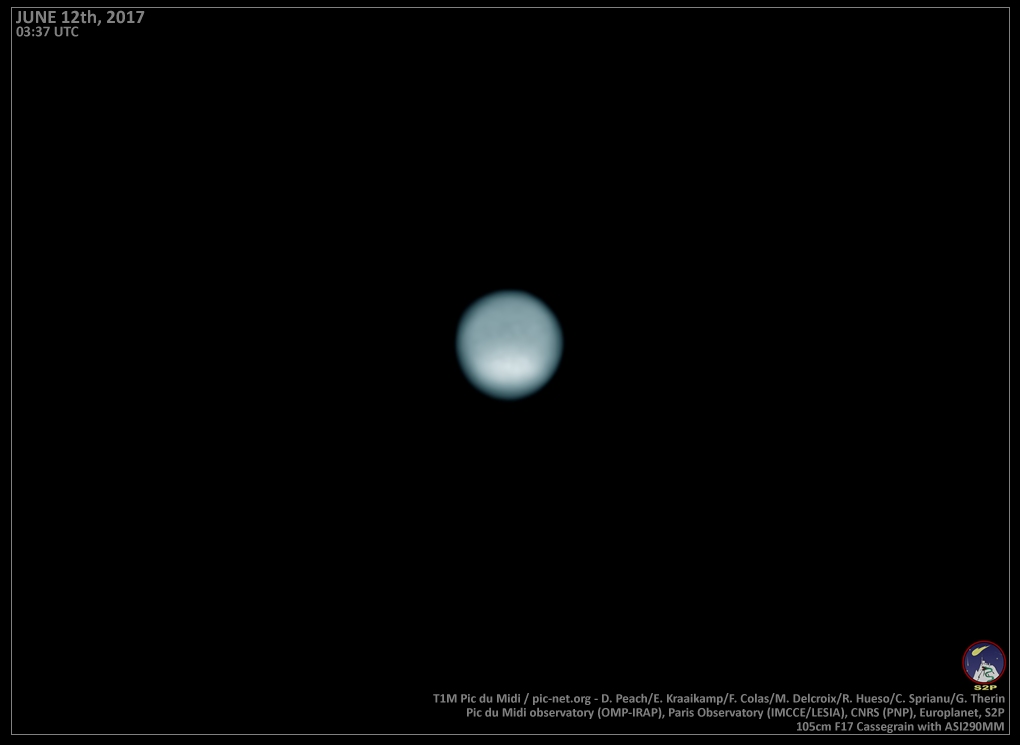


Friday, September 1
• At nightfall, the waxing gibbous Moon is about equally distant from Saturn, well off to its right, and Altair, high to its upper left.
• Near-Earth Asteroid Florence. The 4.4-kilometer asteroid 3122 Florence is passing Earth today at a very safe distance of 7 million km. It will remain about 9th magnitude in fine evening view for small telescopes for several days more. See our article, Asteroid Florence Pays Earth a Visit, with 9th-magnitude finder charts. The asteroid is traveling northward by nearly 10° per day, or 24 arcseconds per minute of time. That's fast enough to see fairly readily, especially when the asteroid is passing close to a background star. Watch for a change in the shape of the pattern it makes with the stars nearest to it.
• A dawn challenge: As morning twilight brightens tomorrow (Saturday September 2nd), use binoculars to look for the triangle of Mars, Regulus, and Mercury very low in the east, far beneath Venus, as shown below. The three are only magnitudes 1.8, 1.4, and a really challenging 3.2, respectively. And that's before atmospheric extinction. Good luck!
Saturday, September 2
• As twilight fades away into night, look far above the Moon for Altair. Much closer above the Moon (more or less), binoculars will show the wide double stars Alpha and Beta Capricorni. Alpha is the yellow-orange pair on top. The Beta pair below it is more unequal and probably harder to resolve.
Sunday, September 3
• Look for bright Vega passing the zenith as twilight fades, if you live in the world's mid-northern latitudes. Vega goes right through your zenith if you're at latitude 39° north (near Baltimore, Kansas City, Lake Tahoe, Sendai, Beijing, Athens, Lisbon).
• As dawn becomes bright on Monday through Wednesday mornings September 4th through 6th, Mars glimmers less than 1° from Regulus very low in the east. Mercury is now about 3° right or upper right of the pair.
Monday, September 4
• As evening grows late, keep watch for 1st-magnitude Fomalhaut to rise about 20° below the nearly full Moon. That's about two fists at arm's length.
Tuesday, September 5
• Full Moon tonight (exactly full at 3:03 a.m. on the 6th EDT). After dark this evening, look for the Great Square of Pegasus balancing on one corner far to the Moon's upper left. Its upper-right side points down toward the Moon. Overhead, Deneb is taking over the role of zenith star from brighter Vega (as seen from mid-northern latitudes).
Wednesday, September 6
• How soon after sunset can you see the big Summer Triangle? Face east. Vega, the Triangle's brightest star, is nearly at the zenith (for skywatchers at mid-northern latitudes). Deneb is the first bright star to Vega's east-northeast. Altair shines less high in the southeast.
Thursday, September 7
• A winter preview: Step out before the first light of dawn this week, and the sky displays the same starry panorama as it does after dinnertime in late January. Orion is striding up in the southeast, with Aldebaran and then the Pleiades high above it. Sirius and Canis Major sparkle below Orion. The Gemini twins are lying on their sides well up in the east.
Friday, September 8
• A dawn challenge: Very low in the east as dawn brightens on Saturday morning the 9th, Mercury, now a respectable magnitude 0, glows 1° to the right of Regulus, magnitude 1.3. Mars, fainter at magnitude 1.8, is about 3° to their lower left, as shown above. Bring binoculars.
Saturday, September 9
• The changes deep in the eastern dawn continue. On Sunday morning the 10th, Mercury glows 1° or less to the lower right of Regulus, while Mars remains below.
________________________
Want to become a better astronomer? Learn your way around the constellations! They're the key to locating everything fainter and deeper to hunt with binoculars or a telescope.
This is an outdoor nature hobby. For an easy-to-use constellation guide covering the whole evening sky, use the big monthly map in the center of each issue of Sky & Telescope, the essential guide to astronomy.

Once you get a telescope, to put it to good use you'll need a detailed, large-scale sky atlas (set of charts). The basic standard is the Pocket Sky Atlas (in either the original or Jumbo Edition), which shows stars to magnitude 7.6.
Next up is the larger and deeper Sky Atlas 2000.0, plotting stars to magnitude 8.5; nearly three times as many. The next up, once you know your way around, is the even larger Uranometria 2000.0 (stars to magnitude 9.75). And read how to use sky charts with a telescope.
You'll also want a good deep-sky guidebook, such as Sue French's Deep-Sky Wonders collection (which includes its own charts), Sky Atlas 2000.0 Companion by Strong and Sinnott, or the bigger Night Sky Observer's Guide by Kepple and Sanner.
Can a computerized telescope replace charts? Not for beginners, I don't think, and not on mounts and tripods that are less than top-quality mechanically (meaning heavy and expensive). And as Terence Dickinson and Alan Dyer say in their Backyard Astronomer's Guide, "A full appreciation of the universe cannot come without developing the skills to find things in the sky and understanding how the sky works. This knowledge comes only by spending time under the stars with star maps in hand."
This Week's Planet Roundup


Mercury, brightening rapidly from magnitude 3 to 0 this week, and Mars, magnitude 1.8, are passing each other very low in the glow of sunrise, well to the lower left of Venus. Regulus is also down there with them, as shown in sky scenes above. Use binoculars.
Venus (magnitude –3.9, in Cancer) shines brightly in the east before and during dawn. Look for Pollux and Castor, much fainter, high above it. Look for Procyon to Venus's upper right, and bright Sirius farther to the right or lower right of Procyon.
Jupiter (magnitude –1.7, in Virgo) is just above the west horizon during twilight and quickly sets. Much fainter Spica is 3° or 4° to its lower left. Again, bring those binoculars.
Saturn (magnitude +0.4, in Ophiuchus above Scorpius) glows in the south-southwest at dusk. Antares, less bright, twinkles 13° to Saturn's lower right.
Uranus (magnitude 5.7, in Pisces) and Neptune (magnitude 7.8, in Aquarius) are well up in the east and southeast, respectively, by late evening. It likely rains diamonds inside them. Use our finder charts.
______________________
All descriptions that relate to your horizon — including the words up, down, right, and left — are written for the world's mid-northern latitudes. Descriptions that also depend on longitude (mainly Moon positions) are for North America.
Eastern Daylight Time (EDT) is Universal Time (UT, UTC, or GMT) minus 4 hours.
______________________
"This adventure is made possible by generations of searchers strictly adhering to a simple set of rules. Test ideas by experiments and observations. Build on those ideas that pass the test. Reject the ones that fail. Follow the evidence wherever it leads, and question everything. Accept these terms, and the cosmos is yours."
— Neil deGrasse Tyson, 2014
______________________
"Objective reality exists. Facts are often determinable. Carbon dioxide warms the globe. Vaccines save lives. Bacteria evolve when challenged by antibiotics. Science and critical thinking are not a political conspiracy. They are how we discover reality. Civilization's survival depends on our ability, and willingness, to do so."
— Alan MacRobert, your Sky at a Glance editor
______________________
"Facts are stubborn things."
— John Adams, 1770
 0
0








Comments
You must be logged in to post a comment.